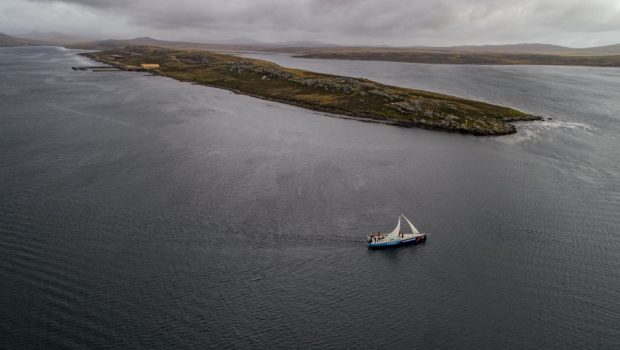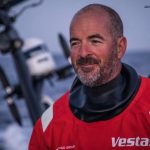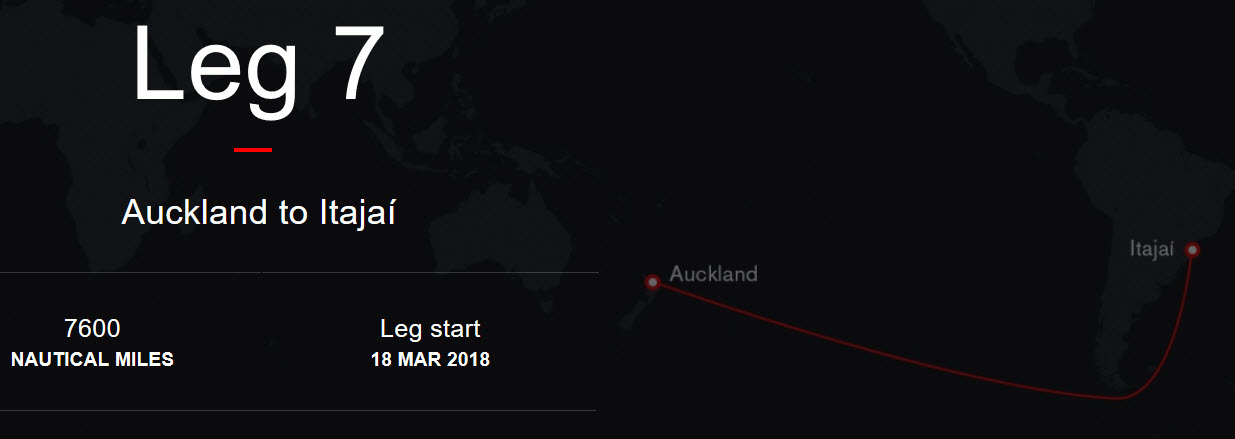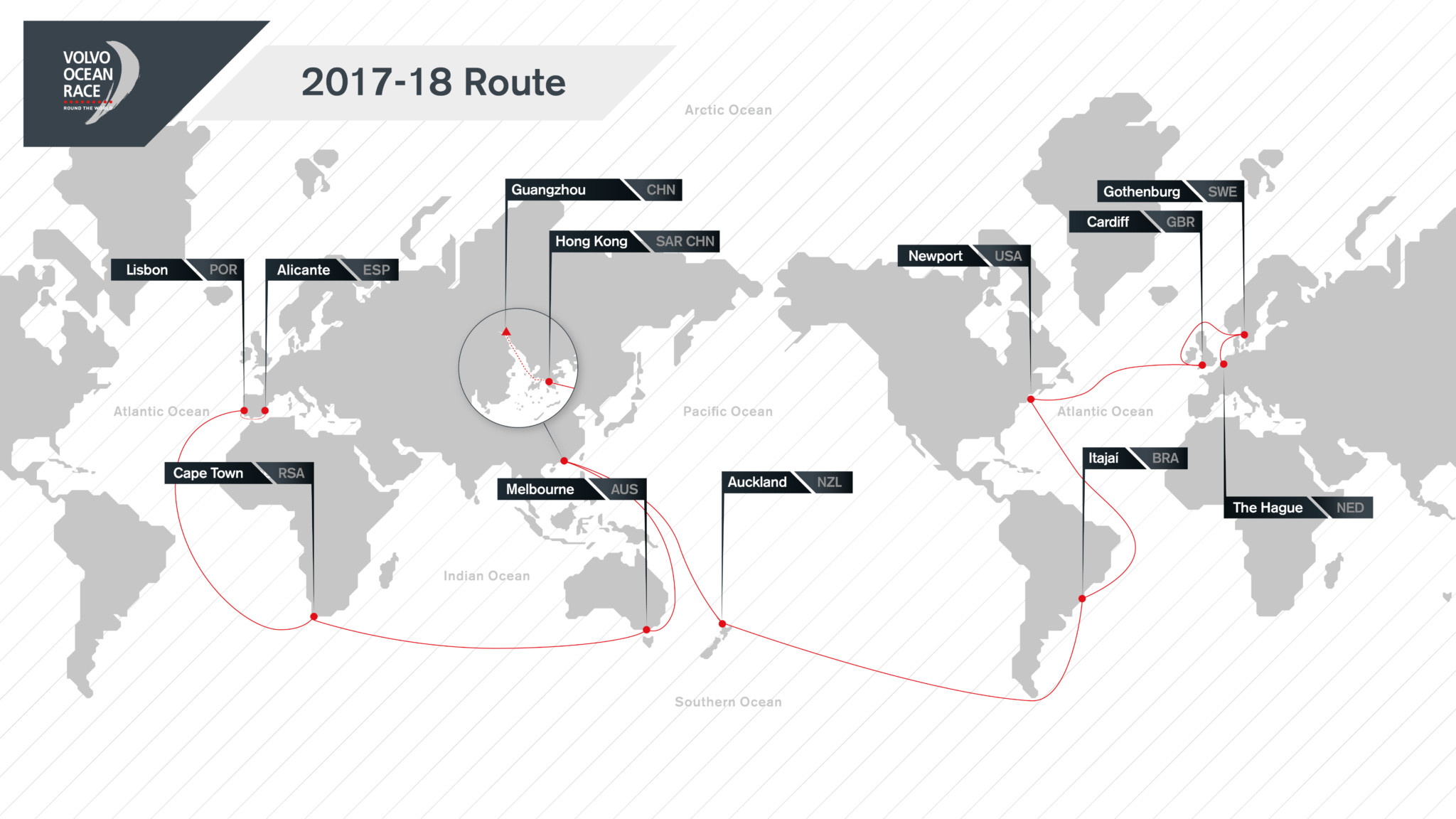Vestas: Eat, Sleep, Helm
Published on April 11th, 2018
There’s not much that six-time Volvo Ocean Race veteran and passionate ocean advocate Damian Foxall hasn’t done when it comes to sailing. Now he leads a five-person delivery crew on the 1500 nm journey to Itajai, Brazil from the Falkland Islands and also takes on the role of Onboard Reporter for Vestas 11th Hour Racing. The team hopes to arrive with enough time to replace the rig and start Leg 8.
“Out of retirement,” our boat captain, Nick Dana told me proudly about the little jury rig constructed from an old aluminum tube. The mast started her life as a streetlamp before being discarded behind a shed on the Falkland Islands to corrode away in the grass.
Left but not forgotten, it was dragged out from the undergrowth by Nick and local Falklander Paul Ellis from Martech Logistics. Measured up, fitted with mast foot, masthead fittings, shroud terminals and, ‘brand new’ rigging, the new mast stands eight meters above the deck – compared to our 30-meter racing rig.
Barely out of the Southern Ocean, the Falklands Islands are still in the roaring 40s and just a ‘hop, skip and jump’ from Antarctica. No custom-built sails for this setup, but a suit of Southern-Ocean-worn cloth, experienced and bleached from hard use around the icy continent kindly contributed from a motley fleet of expedition boats that ply the Southern Ocean.
Three of the best fitting sails were chosen for the trip. An orange storm jib always carried on our VOR 65, flies from the bowsprit to mast tip. The storm jib from Pelagic Exhibitions (run by former Whitbread legend, Skip Novak) also comes out of retirement. The suit is completed with an upside down trysail, the tack pulled up, and the head pulled aft. This new ‘mainsail’ is an optimized deck sweeping canvas, reminiscent of a scow and efficient upwind or on a reach.
The Black-browed Albatross, able to get much closer than usual with the new rig setup, glides an arms reach above the helmsman. Spray spins over the deck, a long slow heel to leeward in the swell then the boat rocks back to weather. With a twitch of one wing, the Albatross does a graceful dive away from the boat to continue its long glides across the spindrift blown wake of the vessel. Las Malvinas (the Spanish name for the Falkland Islands) are now astern, but the cold still hints of the latitude – not far to the ice from here.
“Mesmerizing” is the word I use to describe how one hour blends into another hour as the incessant hum of the engine helps to push the boat north against the near gale-force wind. Albatrosses, fulmars, and petrels glide and dance across the swell tops. Specs of white on grey canvas of the ocean and sky continue their endless search for food on the surface.
The bigger birds glide seemingly almost without effort, playing the updraft of the troughs and crest; the smaller birds crisscross with unbelievable speed, flying around the peaks and somehow avoid each other. This is no mean feat with more than 20 birds following the wake.
How do they decide what to pick up? Anything that is different and stands out? Does color make a difference? I look closely but for all the hours gazing at the aerial spectacle I don’t once see them pick something up, too quick for the eye? Or too scarce the food?
The hour at the helm is too short and eagerly taken by the next pilot as the five-man crew rotates one-hour driving, one on deck, then three hours off. Eat, sleep, helm is life onboard.
Last night, the horizon was lit up like a small city, but it is the row upon row of industrial squid boats fishing off the 200 nm exclusive economic zone of the Argentinian border. Apparently, they cannot get any closer to the country, or they risk being impounded by the local navy.
For half the night this unnatural light show makes me regret having enjoyed calamari at dinner prior to departure. I reinforce my idea once again not to eat any seafood I haven’t caught myself. By morning, the horizon is clear and golden edges light the clouds. The Black-browed Albatross is back again, or still with us?
Not superstitious, but like all seafarers, we take the bird’s calm majestic presence as a good omen, and while on watch, our thoughts wander…
Damian’s commitment to catch his own seafood is his commitment to eating sustainable seafood. For those not lucky enough to spend as much time on the water, you can ensure you’re also eating sustainable seafood by asking how and where it was caught or farmed, and using the Monterey Bay Seafood Watch Guide.
COURSE: Starting on March 18, Leg 7 took the teams from Auckland, New Zealand to Itajaí, Brazil. Race organizers choose to estimate the tactical distance for each leg rather than list the actual distance, an unusual decision that’s revealed once the race starts and the tracker lists the actual distance to finish. The VOR says Leg 7 is 7600 nm whereas the truth is more like 6623 nm.
For crew lists … click here.
Race details – Tracker – Scoreboard – Race route – Facebook – YouTube
Leg 7 – Final Results
1. Team Brunel (NED), Bouwe Bekking (NED), Finished on Apr 3 at 14:45:18 UTC
2. Dongfeng Race Team (CHN), Charles Caudrelier (FRA), Finished on Apr 3 at 15:00:08 UTC
3. Team AkzoNobel (NED), Simeon Tienpont (NED), Finished on Apr 5 at 04:38:24 UTC
4. Turn the Tide on Plastic (POR), Dee Caffari (GBR), Finished on Apr 7 at 04:12:44 UTC
5. MAPFRE (ESP), Xabi Fernández (ESP), Finished on Apr 8 at 07:59:09 UTC
RET. Vestas 11th Hour Racing (DEN/USA), Charlie Enright (USA)
RET. Team Sun Hung Kai/Scallywag (HKG), David Witt (AUS)
DTF – Distance to Finish; DTL – Distance to Lead; RET – Retired
Overall Results (after 7 of 11 legs)
1. Dongfeng Race Team (CHN), Charles Caudrelier (FRA), 46 points
2. MAPFRE (ESP), Xabi Fernández (ESP), 45
3. Team Brunel (NED), Bouwe Bekking (NED), 36
4. Team AkzoNobel (NED), Simeon Tienpont (NED), 33
5. Team Sun Hung Kai/Scallywag (HKG), David Witt (AUS), 26
6. Vestas 11th Hour Racing (DEN/USA), Charlie Enright (USA), 23
7. Turn the Tide on Plastic (POR), Dee Caffari (GBR), 20
2017-18 Edition: Entered Teams – Skippers
• Team AkzoNobel (NED), Simeon Tienpont (NED)
• Dongfeng Race Team (CHN), Charles Caudrelier (FRA)
• MAPFRE (ESP), Xabi Fernández (ESP)
• Vestas 11th Hour Racing (DEN/USA), Charlie Enright (USA)
• Team Sun Hung Kai/Scallywag (HKG), David Witt (AUS)
• Turn the Tide on Plastic (POR), Dee Caffari (GBR)
• Team Brunel (NED), Bouwe Bekking (NED)
Background: Racing the one design Volvo Ocean 65, the 2017-18 Volvo Ocean Race begins in Alicante, Spain on October 22 2017 with the final finish in The Hague, Netherlands on June 30 2018. In total, the 11-leg race will visit 12 cities in six continents: Alicante, Lisbon, Cape Town, Melbourne, Hong Kong, Guangzhou, Auckland, Itajaí, Newport, Cardiff, Gothenburg, and The Hague. A maximum of eight teams will compete.
Source: Team Vestas 11th Hour Racing, Volvo Ocean Race












 We’ll keep your information safe.
We’ll keep your information safe.